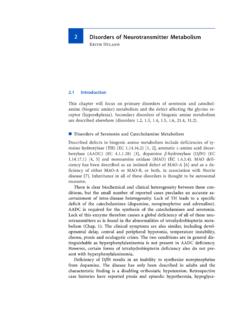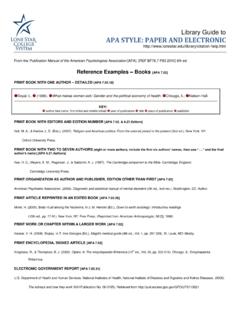Transcription of Mechanisms Underlying Responsiveness to ...
1 RESEARCH ARTICLEM echanisms Underlying Responsiveness toTetrahydrobiopterin in mild PhenylketonuriaMutationsAngel L. Pey,1 Bele nPe rez,1 Lourdes R. Desviat,1 MaAngeles Mart nez,1 Cristina Aguado,1 Heidi Erlandsen,2 Alejandra Ga mez,2 Raymond C. Stevens,2 Matth as Tho ro lfsson,3 Magdalena Ugarte,1nand Aurora Mart nez31 Centro de Biolog a Molecular Severo Ochoa, CSIC-Universidad Auto noma de Madrid, Madrid, Spain;2 The Scripps Research Institute,Department of Molecular Biology, La Jolla, California;3 Department of Biomedicine, University of Bergen, Bergen, NorwayCommunicated by Linda TyfieldA subtype of phenylalanine hydroxylase (PAH) deficiency that responds to cofactor ( tetrahydrobiopterin , BH4)supplementation has been associated with phenylketonuria (PKU) mutations.
2 The Underlying molecularmechanism of this Responsiveness is as yet unknown and requires a detailed in vitro expression analysis of theassociated mutations. With this aim, we optimized the analysis of the kinetic and cofactor binding properties inrecombinant human PAH and in seven mild PKU mutations, , ( ), ( ), ( ), ( ), ( ), ( ), ( ) expressed inE. coli. For , , and , we could in addition studythe equilibrium binding of BH4to the tetrameric forms by isothermal titration calorimetry (ITC). All themutations resulted in catalytic defects, and , , , and most probably , showedreduced binding affinity for BH4. The possible stabilizing effect of the cofactor was explored using a cell-freein vitro synthesis assay combined with pulse-chase methodology.
3 BH4prevents the degradation of the proteinsof folding variants , , and , acting as a chemical chaperone. In addition, for wild-typePAH and all mild PKU mutants analyzed in this study, BH4increases the PAH activity of the synthesizedprotein and protects from the rapid inactivation observed in vitro. Catalase and superoxide dismutase partiallymimic this protection. All together, our results indicate that the response to BH4substitution therapy by PKUmutations may have a multifactorial basis. Both effects of BH4on PAH, , the chemical chaperone effectpreventing protein misfolding and the protection from inactivation, may be relevant Mechanisms of theresponsive phenotype. Hum Mutat 24:388 399, Wiley-Liss, WORDS: phenylketonuria , mild ; PKU; PAH; BH4- Responsiveness ; tetrahydrobiopterin ; cofactor replacementtherapyDATABASES:PAH OMIM: 261600; GenBank: (cDNA), NM_000277 (cDNA), AF404777 (gDNA); Swiss-Prot:P090439; (PAHdb); ( tetrahydrobiopterin Home Page)INTRODUCTION(6R)-L-erythro-5,6,7,8- tetrahydrobiopterin (BH4)isthe essential cofactor in the hydroxylation of L-Phecatalyzed by the nonheme iron-dependent phenylalaninehydroxylase (PAH), using dioxygen as additional sub-strate.
4 A deficiency in any of the components of the PAHsystem results in hyperphenylalaninemia (HPA), and themajority of these deficiencies are caused by mutations inthe PAH gene (MIM# 261600). According to patientphenotypes, the HPAs can be categorized as classicalphenylketonuria (PKU), moderate PKU, mild PKU, andmild HPA [Scriver and Kaufman, 2001]. More infre-quent forms of HPA are due to defects in thebiosynthesis or regeneration of BH4[Blau et al., 2001].A standardized BH4loading test allows the distinctionbetween PAH and BH4defects. No decline of plasmaphenylalanine levels is expected in PAH deficiency,whereas in defects of enzymes involved in either theReceived 19 February 2004; accepted revised manuscript 17 to: Magdalena Ugarte, Centro de Biolog| aMole-cular Severo Ochoa CSIC-UAM, Universidad Auto noma de Madrid,Campus de Cantoblanco,28049 Madrid, : sponsor: Ministerio de Sanidad y Consumo; Grant numbers:REDEMETH G03/054; PI020117; Grant sponsor: Comisio nIntermi-nisterial de Ciencia y Tecnolog| a, Spain; Grant number: SAF2001-0544.
5 Grant sponsors: Research Council of ( ).rr2004 WILEY-LISS, mutation 24:388^399 (2004)synthesis or regeneration of BH4, the phenylalaninelevels are normalized within 4 8 hr after BH4loading[Blau et al., 1994]. Kure et al. [1999] reported for thefirst time several patients with a PAH deficiency showinga normalization of plasma phenylalanine concentrationafter oral administration of BH4. Since then, there havebeen an ever increasing number of reports of BH4responsiveness in PKU patients [for reviews see Erland-sen and Stevens, 2001; Spaapen and Rubio-Gozalbo,2003; Blau et al., 2004]. This has lead to the definition ofa novel subtype of PAH deficiency, and suggests atherapeutic potential for BH4that may overcome thepsychosocial burden of a restricted dietary therapy in asubset of PKU patients.
6 Some mutations, characterizedby their high residual activity when analyzed in vitro[Spaapen and Rubio-Gozalbo, 2003], are repeatedlyfound to be associated with this type of PAH deficiency,leading to the suggestion that Responsiveness is deter-mined by the nature of the mutations. However, thereare patients with identical genotypes showing a dis-cordant response to a BH4loading test, suggesting thatother factors ( , intragenic polymorphisms, modifiergenes, or nongenetic factors) also determine the responseto cofactor supplementation [Lindner et al., 2003].The tetrameric PAH enzyme belongs to the family ofaromatic amino acid hydroxylases sharing a similarenzyme mechanism and a common structural 3D-structure of different truncated forms of humanand rat PAH has been determined, providing essentialinformation on the active-site structure and the residuesinvolved in binding of the substrate L-Phe and thecofactor BH4[Andersen et al.]
7 , 2002; Teigen et al., 1999],and offering a framework in which to interpret thestructural effects of the disease-causing mutations[Erlandsen et al., 1997; Fusetti et al., 1998; Kobe et al.,1999]. PAH has a three-domain structure consisting of aregulatory domain containing an N-terminal autoregula-tory sequence stretching over the active site, a catalyticdomain including the active site iron and the substrateand BH4binding sites, and a C-terminal oligomerizationdomain [Erlandsen et al., 1997; Fusetti et al., 1998; Kobeet al., 1999]. The substrate L-Phe, which activates theenzyme, is proposed to induce a conformational changethat displaces the autoregulatory sequence from theactive site [Kobe et al.
8 , 1999; Tho ro lfsson et al., 2003].BH4, on the contrary, acts as a negative regulator,inducing a low-activity conformational state, blockingL-Phe activation and disfavoring phosphorylation atSer16 [Jennings et al., 2001; Kaufman, 1993; Teigenand Martinez, 2003; Solstad et al., 2003].The need for a more correct classification of potentialBH4-responsive patients according to their genotype andbiochemical phenotype, as well as for the elucidation ofthe molecular mechanism Underlying BH4responsive-ness, has been stressed [Ponzone et al., 2003]. Severalpossibilities have been put forward, alone or incombination, to explain the response to BH4in mildPKU [Erlandsen and Stevens, 2001; Muntau et al.
9 , 2002;Spaapen and Rubio-Gozalbo, 2003; Steinfeld et al.,2003]: 1) correction of a catalytic defect of the mutantproteins (decreased affinity for BH4); 2) stabilization ofthe mutant proteins, , BH4could act as a chemicalchaperone, protecting the active tetramer/dimer formsfrom proteolytic cleavage; 3) upregulation of PAH geneexpression levels, as recently shown for the hph1 mouse[Hyland and Munk-Martin, 2001]; or 4) PAH mRNAstabilization, similarly to the effect of BH4on induciblenitric oxide synthase mRNA [Linscheid et al., 1998].The most generalized assumption is that mutationsassociated with BH4responsiveness result inKmvariants(decreased BH4binding affinity) of the PAH enzyme,and BH4therapy of mild PKU would then join the list ofhigh-dose vitamin treatments that are available tocorrect mutation induced decreased binding affinity forcertain coenzymes [Ames et al.
10 , 2002]. Many of theseBH4-responsive PKU mutations map to the catalyticdomain in regions that interact with secondary elementsinvolved in cofactor binding [Erlandsen and Stevens,2001]. However, without expression analysis and kineticmeasurements of the mutant proteins, the currentunderstanding of the mechanism of BH4responsivenessis incomplete. In this work, we analyzed the kineticbehavior of recombinantly expressed PAH proteinscorresponding to frequent PKU mutations present inBH4-responsive patients ( , ( ), ( ), ( ), ( ), and ( ))[Lassker et al., 2002; Muntau et al., 2002; Spaapen andRubio-Gozalbo, 2003], or to rare mutations selected fromprevious expression studies that suggested they couldcorrespond to defects in cofactor binding ( , ( ) and ( ))[Pey et al.








